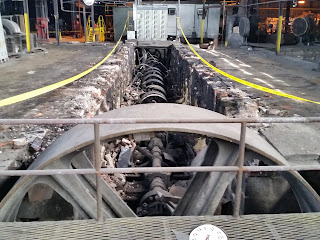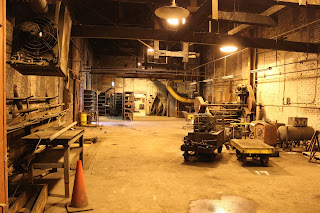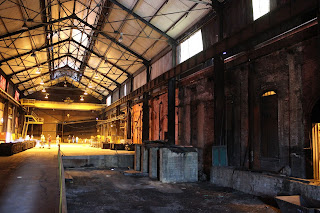(
HAER;
Satellite, it is now a townhouse development [
TimesLeaderOnline])
Unfortunately,
this web site is broke because it still requires Adobe Flash Player.
"At the LaBelle works in Wheeling, cut nails have been manufactured continuously since 1852. Wheeling LaBelle cut nails are used widely in the building industry of hardwood flooring and building block construction." [
OhioCountyLibrary, 1956]
 |
HAER WVA,35-WHEEL,38--19
19. INTERIOR VIEW, GENERAL VIEW OF MAIN FLOOR OF NAIL WORKS SHOWING THE BANKS OF NAIL CUTTING MACHINES - LaBelle Iron Works, Thirtieth & Wood Streets, Wheeling, Ohio County, WV |
History of the Ohio Valley
posted two photos with the comment: "This photo was taken Workers at the LaBelle Cut Nail Plant in South Wheeling in the early 1900s. The plant was in operation from 1852-2010, and was the world’s largest cut nail plant for most of that time. At the time of it’s closure, the machinery dated from 1852-1860, and was still in working order. The second photo shows the plant in July, 1990. The building was demolished in 2017, and the “LaBelle Green” apartment housing sits upon the site today."
Bill Sutliff: Those LaBelle hardened cut nails are the best masonry nails ever! I buy them at auctions or flea markets when I can find them.
 |
| 1 |
The ancestor company was founded in 1852. Of course, in 1852 a
line shaft would have been powered by a steam engine. They converted to electricity by replacing the steam engine with two large electrical mill motors. But they finally converted to using a motor for each machine in the 1960s for safety reasons. [
TimesLeaderOnline] "When the use of cut nails declined in the 1880s, LaBelle changed with the times as they diversified their products and switched to manufacturing tin plates, and later produced steel plates, tubes, and sheets. Wheeling Steel Corporation, later [1967] Wheeling-Pittsburgh Steel Corporation, was formed in 1920 by combining LaBelle, Wheeling Iron and Steel, and Whitaker-Glessner Company." [
theclio] (The fact that it was two large motors came from
here.)
 |
E-WV / WV Humanitites Council via wvpublic
"La Belle kept producing cut nails and developed a specialized market in hardened nails for masonry work." The 2008 recession and foreign competition caused its closure in 2010.
[I wondered why cut nails were still being produced in the 21st Century.] |
I need to learn how to access the timeline feature of Google Map's street view.
 |
The Ohio County Public Library
[I cannot reconcile this photo with some other photos nor topo maps.]
"Wheeling’s nail production from 1871-1873 (three million kegs) comprised nearly a quarter of the national nail production (12 million kegs). The dominance of the cut nail was to be short-lived, however, as the 'Great Nail Strike' of 1885-1886 severely impacted the industry and allowed the wire nail producers to corner the market. The nailers went on strike to protest the newly adopted Bessemer process, which replaced wrought iron with steel plate as the material used to make the nails. The cut nail market would never quite recover. By 1914, La Belle was the only company in Wheeling producing cut nails."
[The same text is in ArchivingWheeling. That web page acknowledges the source of the text: Maddox, Lee R., “La Belle Iron Works.” Report. Historic American Engineering Record. Washington, DC: National Park Service, Department of the Interior, 1990. Or HAER-data] |
Given the lack of shields on the belts, I don't think they converted in the 1960s because of safety issues. My guess is that the workers who knew how to maintain the line-shaft equipment were retiring.
 |
HAER WVA,35-WHEEL,38--21
21. INTERIOR VIEW, UNDER THE MAIN FLOOR SHOWING THE LINESHAFT SYSTEM ONCE POWERED BY A STEAM ENGINE AND LATER BY TWO LARGE ELECTRICAL MILL MOTORS (NOTICE LARGE GEAR IN FOREGROUND) THAT OPERATED EACH NAIL MACHINE; PRESENTLY THE NAIL MACHINES ARE DRIVEN BY INDIVIDUAL ELECTRICAL MOTORS - LaBelle Iron Works, Thirtieth & Wood Streets, Wheeling, Ohio County, WV |
In this case the replacement motors were mounted above the machines. Note the cut nails coming out of the bottom of the machines. They had a sequence of photos showing the feeder adding another strip of steel as the machines were running.
 |
HAER WVA,35-WHEEL,38--26
26. INTERIOR VIEW, SAME AS ABOVE BUT WITH MOTION STOPPED PHOTOGRAPHY; NOTE PRY BAR IN FEEDER'S RIGHT HAND - LaBelle Iron Works, Thirtieth & Wood Streets, Wheeling, Ohio County, WV |
 |
WVA,35-WHEEL,38--30
30. INTERIOR VIEW, DETAIL OF NAIL CUTTING KNIFE AND BARREL WITH FEEDER ROD INSERTED - LaBelle Iron Works, Thirtieth & Wood Streets, Wheeling, Ohio County, WV |
 |
WVA,35-WHEEL,38--38
38. INTERIOR VIEW, SAME GRINDSTONES AS ABOVE SHOWING NAILER SHARPENING A NAIL CUTTING KNIFE - LaBelle Iron Works, Thirtieth & Wood Streets, Wheeling, Ohio County, WV |
 |
HAER WVA,35-WHEEL,38--61
61. INTERIOR VIEW, IN PLANT SUPERINTENDENTS OFFICE OF EARLY DISPLAY OF ALL THE TYPES AND SIZES OF NAILS PRODUCED - LaBelle Iron Works, Thirtieth & Wood Streets, Wheeling, Ohio County, WV |


































No comments:
Post a Comment